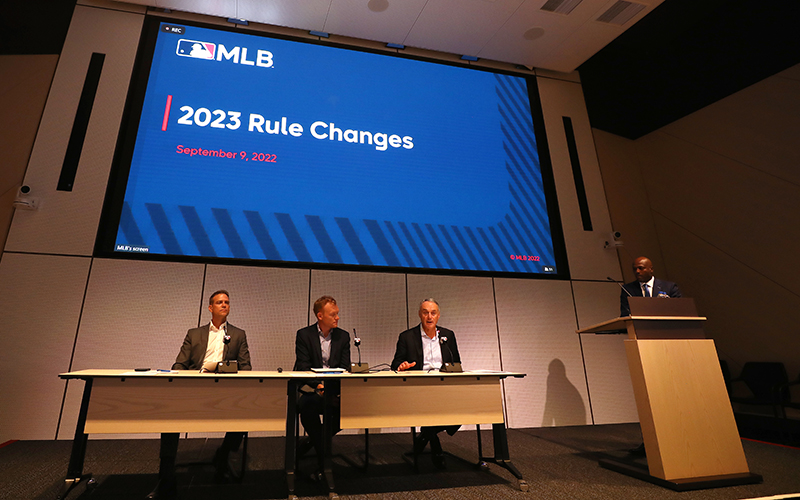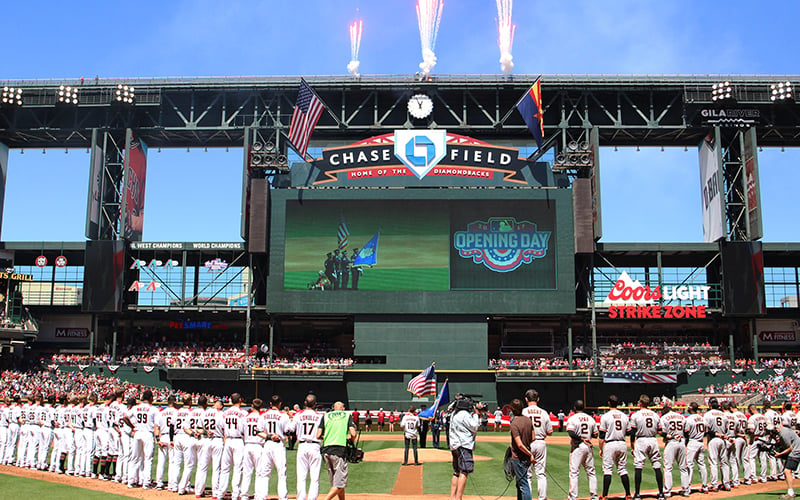
MLB Commissioner Rob Manfred, right, announced three rule changes in September during the MLB Rules Press Conference at MLB Headquarters. The Arizona Fall League adopted the changes this past season. (Photo by Eve Kilsheimer/Getty Images)
SCOTTSDALE – For baseball fans who want to get a glimpse of what rule changes in the major leagues will look like next season, they need to look no further than the Arizona Fall League.
In September, Major League Baseball announced three major rule changes that will be implemented in 2023, including the addition of a pitch clock, a ban on defensive shifts and using enlarged bases.
Although MLB systematically tested all of the new rules in the minor leagues over the past two seasons, the Arizona Fall League this year was the first opportunity for players to experience all of the rule changes at once in a league.
“It’s cool to be the test subjects of the MLB,” said St. Louis Cardinals prospect Jordan Walker. “A lot of these guys out here in the Fall League are going to be in the majors next year, so they get a sneak peek of what’s to come. It’s been fun.”
The goal of the rule changes is to speed up the game while giving fans more action. MLB research shows that fans want faster-paced games, more stolen bases and more extra-base hits. Instead, the research shows the game has trended toward longer games, more strikeouts, lower baseball-wide batting averages and fewer stolen bases.
In a nutshell, games have gotten longer with less action. In 2022, the baseball-wide batting average was .243 while the strikeout rate was the highest it’s ever been at 22.3%, and the average major league game lasted for three hours, seven minutes.
Along with the three new rules that will be implemented in the majors next season, the Arizona Fall League used an Automatic Ball-Strike Challenge System, or “ABS” for short, in 2022. ABS allows pitchers, hitters or catchers to challenge an umpire’s ball or strike call.
The ABS system is being used at an experimental level in the Arizona Fall League but won’t make an appearance next season in the MLB. However, it added a fun, new element for fans during some Fall League play. Each team was allowed three challenges per game, but if a player’s challenge is successful, his team got that challenge back.
The system was used only at the Salt River Fields in Scottsdale, where the Salt River Rafters play. It also was used during the inaugural Chase Field tripleheader played last month in downtown Phoenix.
“I’m really a fan of the challenge system,” said Texas Rangers catcher Cody Freeman. “It’s cool to get a limited amount of opportunities to be able to let everyone know if you’re right or wrong about a call. If there were challenges all game, I wouldn’t be a fan. But having it maximized to three chances is perfect.”
Out of the three changes that MLB made for next season, the one that most players and fans have been talking about is the addition of a pitch clock. Use of a pitch clock is the biggest component of MLB’s effort to whittle down the average of three hours and seven minutes games lasted in 2022. MLB research concluded that the “ideal” time for a game is two and a half hours.
The new rule limits pitchers to 30 seconds between batters and there is a 15-second limit between pitches when the bases are empty and a 20-second limit if there are runners on base.
The timer was tested in the minor leagues over the last two seasons and reduced the average time of games by a whopping 26 minutes.
However, there has been a mixed reaction to the pitch clock. Predictably, most pitchers don’t like it.
Some insist that rushing to beat the clock will disrupt their natural motion. Others claim that the rule isn’t in keeping with the “tradition” of baseball, including Nationals ace Max Scherzer, who told ESPN.com that the rule is “messing with the fabric of the game.”
However, most players in the Fall League are fans of the pitch clock.
“Everyone is voting for it,” Freeman said. “I’m a fan of it. I played with it last year, and it just speeds up the game. The fans love that.”
Former Miami Marlins pitcher Justin Fall, an Arizona State product, also believes the pitch clock is a good thing for baseball’s future.
“Everyone here doesn’t want to be here for four hours,” Fall said. “If we can get the game within two to two and a half hours, I think that helps everyone. I’ve always been the kind of guy that works fast on the mound anyway.”
The change to larger bases is another rule that most Fall League players have met with a shrug.
In the past, the bags at first, second, and third base measured 15 inches square. Beginning next season, the bases will be 18 inches square. MLB officials cited player safety as the primary reason for the increase in base size because it results in a wider basepath, giving players more room to operate to avoid collisions – and tags. The bigger bases also slightly shorten the distance between bags, which MLB hopes will contribute to more stolen base attempts, and therefore more action and more scoring.
Ronny Simon, a shortstop for the Tampa Bay Rays, said the bigger bases give players more reason to steal and to run harder on an attempt because they have a bigger target to hit. He also noted that it felt peculiar during the Chase Field tripleheader last month because the 15-inch bases were used, forcing the players to re-adjust to the smaller bags just for that day.
All in all, Fall League players welcomed the new rules and are optimistic about improving the game for fans.
“It feels great to be a part of this,” said Texas Rangers pitcher Kumar Rocker. “You’ve got to be adaptable as a player, so the Fall League is a great chance to learn these rules and get accustomed to them.”

